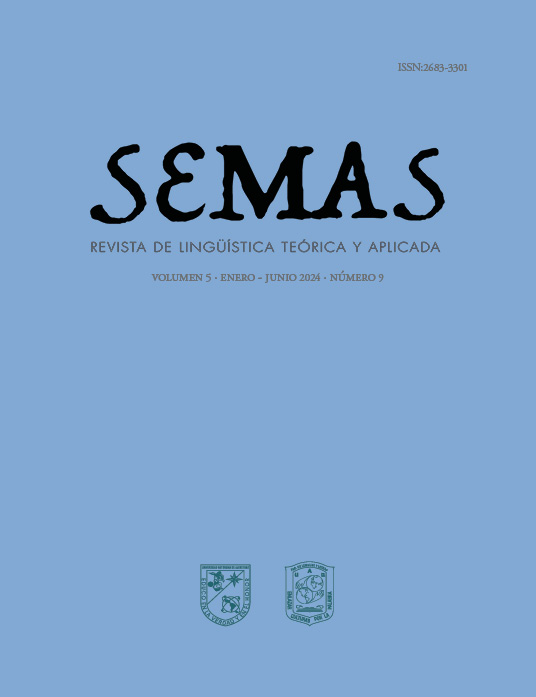Past tenses in narrative production. How do advanced speakers of Spanish as a second language compare to native speakers?
DOI:
https://doi.org/10.61820/hdgzzs32Palabras clave:
tiempos verbales del español, polisemia, adquisición de una lengua segunda, pragmática, análisis de corpusResumen
Past tense acquisition presents a challenge for learners of Spanish as a second language (L2). Previous research in Second Language Acquisition (SLA) has primarily focused on the paradigmatic relationships between simple past tenses (cantó and cantaba) where the change of form entails a change of meaning. The paradigmatic relationships that exist between different tenses to express the same meaning, as well as verbal tense polysemy, have received less attention. To address these gaps, we introduce the Function-Meaning-Form model, and we apply it to analyze a corpus of written narratives, produced by L1 and advanced L2 Spanish speakers, based on a film excerpt. Through this analysis, we explore tense polysemy and investigate differences between advanced and native speakers in handling this phenomenon. Our findings reveal a significant difference between groups in their approach to verbal tense polysemy.
Descargas
Referencias
Alba de la Fuente, A. and Cruz Enríquez, M. (2023). “De la lingüística a la clase de ELE: propuesta para la enseñanza de los tiempos verbales”. Congreso de la Asociación Canadiense de Hispanistas. Ottawa, 3-5 junio, 2023.
Bardovi-Harlig, K. (1998). “Narrative structure and lexical aspect: Conspiring factors in second language acquisition of tense-aspect morphology”. Studies in Second Language Acquisition, 20(4), pp. 471-508. https://www.cambridge.org/core/journals/studies-in-second-language-acquisition/article/abs/narrative-structure-and-lexical-aspect/95A2E43636B57F33D179934F85D925E1
Bardovi-Harlig, K. (2000). “Tense and aspect in second language acquisition: Form, meaning, and use”. Language Learning: A Journal of Research in Language Studies, 50(1).
Benveniste, É. (1966). Problèmes de linguistique générale I. Gallimard.
Crossley, S., Salsbury, T., & McNamara, D. (2010). “The Development of Polysemy and Frequency Use in English Second Language Speakers”. Language Learning, 60(3), 573-605. https://doi.org/10.1111/j.1467-9922.2010.00568.x
Cruz Enríquez, M. (2019). Función-significado-forma: Un modelo para el estudio de los tiempos verbales del español. (Tesis de Doctorado) Université de Montréal. https://papyrus.bib.umontreal.ca/xmlui/handle/1866/22635
Cruz Enríquez, M. (2022). “Nueva propuesta bipartita de clasificación de los verbos según el aspecto léxico”. Hispanic Studies Review 6(2) pp. 1-20. https://hispanicstudiesreview.cofc.edu/article/35730-nueva-propuesta-bipartita-de-clasificacion-de-los-verbos-segun-el-aspecto-lexico
Cruz Enríquez, M. and Alba de la Fuente, A. (2024). “Explorando estrategias óptimas para enseñar los tiempos verbales en ELE: ¿Priorizar más formas o más significados?” [Unpublished manuscript]. Université TÉLUQ and Université de Montréal.
Dik, S. C. (1987). “Copula auxiliarization: How and why?” In M. Harris & P. Ramat (Eds.), Historical Development of Auxiliaries. (pp. 53-84). Berlin: Mouton de Gruyter.
Elston-Güttler, K. E., & Williams, J. N. (2008). “First language polysemy affects second language meaning interpretation: Evidence for activation of first language concepts during second language reading”. Second Language Research, 24(2), 167-187. https://doi.org/10.1177/0267658307086300
González, P. (2003). Aspects on Aspect. Theory and Applications of Grammatical Aspect in Spanish. Universiteit Utrecht.
Halliday, M. (1985). An Introduction to Functional Grammar. London: Edward Arnold.
Hasbún, L. M. (1995). The role of lexical aspect in the acquisition of the tense/aspect system in L2 Spanish. Indiana University.
Howard, M. (2005). “Les contextes prototypiques et marqués de l’emploi de l’imparfait par l’apprenant du français langue étrangère”. In E. Labeau & P. Larrivée (Eds.), Nouveaux développements de l’imparfait (pp. 175-197). Amsterdam: Rodopi.
Izquierdo, J. (2009). “L’ aspect lexical et le développement du passé composé et de l’imparfait en français L2: Une étude quantitative auprès d’apprenants hispanophones”. Canadian Modern Language Review, 65(4), pp. 587-613. https://doi.org/10.3138/cmlr.65.4.587
Lareau, F. (2008). Vers une grammaire d’unification Sens-Texte du français: Le temps verbal dans l’interface sémantique-syntaxe (Tesis de doctorado) Université de Montréal.
Llopis-García, R., Real Espinosa, J. M. y Ruiz Campillo, J. P. (2012). Qué gramática enseñar, qué gramática aprender. Madrid: Edinumen.
Reichenbach, H. (1947). Elements of Symbolic Logic. Los Ángeles: The Free Press.
Salaberry, R. (2011). “Assessing the effect of lexical aspect and grounding on the acquisition of L2 Spanish past tense morphology among L1 English speakers”. Bilingualism: Language and Cognition, 14(02), pp. 184-202. http://doi:10.1017/S1366728910000052
Slabakova, R. & Montrul, S. (2002). “On viewpoint aspect interpretation and its L2 acquisition”. In R. Salaberry & Y. Shirai (Eds.), The L2 acquisition of tense-aspect morphology (pp. 363-395). Amsterdam: John Benjamins Publishing Company
Vet, C. (2007). “The descriptive inadequacy of reichenbach’s tense system: A new proposal”. Cahiers Chronos, 17, pp. 7-26.
Weinrich, H. (1973). Le Temps: Le récit et le commentaire. Éditions du Seuil.
Publicado
Número
Sección
Licencia
Derechos de autor 2024 Semas

Esta obra está bajo una licencia internacional Creative Commons Atribución 4.0.
Aquellos autores que tengan publicaciones con esta revista aceptan los términos siguientes:
- Los autores garantizarán a la revista el derecho de primera publicación de su obra, el cual estará simultáneamente sujeto a la Licencia de reconocimiento de Creative Commons que permite a terceros compartir la obra bajo los mismos acuerdos en que está formulada la Licencia que se especifica, siempre que se indique su autor y su primera publicación en esta revista.
- Los autores podrán adoptar otros acuerdos de licencia no exclusiva de distribución de la versión de la obra publicada siempre que se indique la publicación inicial en esta revista.
- Se permite y recomienda a los autores la difusión de su obra a través de Internet, lo cual podría producir intercambios interesantes y aumentaría las citas de la obra publicada.
Los trabajos publicados en Semas. Revista de Lingüística Teórica y Aplicada se publican bajo los términos que se indican en la Licencia de Creative Commons con la Atribución 4.0 Internacional (CC BY 4).





